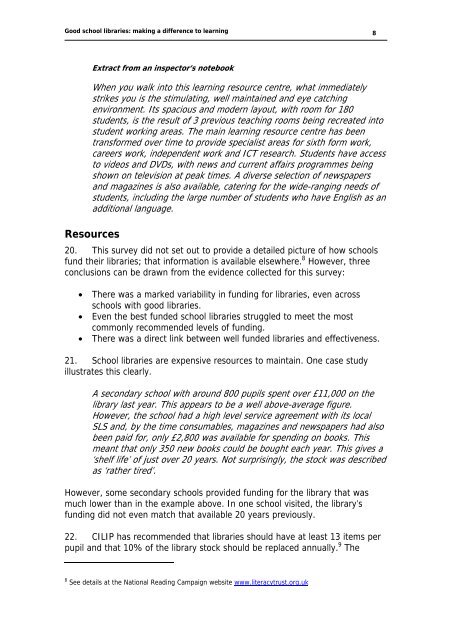Good school libraries: - Digital Education Resource Archive (DERA)
Good school libraries: - Digital Education Resource Archive (DERA)
Good school libraries: - Digital Education Resource Archive (DERA)
Create successful ePaper yourself
Turn your PDF publications into a flip-book with our unique Google optimized e-Paper software.
<strong>Good</strong> <strong>school</strong> <strong>libraries</strong>: making a difference to learning 8<br />
Extract from an inspector’s notebook<br />
When you walk into this learning resource centre, what immediately<br />
strikes you is the stimulating, well maintained and eye catching<br />
environment. Its spacious and modern layout, with room for 180<br />
students, is the result of 3 previous teaching rooms being recreated into<br />
student working areas. The main learning resource centre has been<br />
transformed over time to provide specialist areas for sixth form work,<br />
careers work, independent work and ICT research. Students have access<br />
to videos and DVDs, with news and current affairs programmes being<br />
shown on television at peak times. A diverse selection of newspapers<br />
and magazines is also available, catering for the wide-ranging needs of<br />
students, including the large number of students who have English as an<br />
additional language.<br />
<strong>Resource</strong>s<br />
20. This survey did not set out to provide a detailed picture of how <strong>school</strong>s<br />
fund their <strong>libraries</strong>; that information is available elsewhere. 8 However, three<br />
conclusions can be drawn from the evidence collected for this survey:<br />
• There was a marked variability in funding for <strong>libraries</strong>, even across<br />
<strong>school</strong>s with good <strong>libraries</strong>.<br />
• Even the best funded <strong>school</strong> <strong>libraries</strong> struggled to meet the most<br />
commonly recommended levels of funding.<br />
• There was a direct link between well funded <strong>libraries</strong> and effectiveness.<br />
21. School <strong>libraries</strong> are expensive resources to maintain. One case study<br />
illustrates this clearly.<br />
A secondary <strong>school</strong> with around 800 pupils spent over £11,000 on the<br />
library last year. This appears to be a well above-average figure.<br />
However, the <strong>school</strong> had a high level service agreement with its local<br />
SLS and, by the time consumables, magazines and newspapers had also<br />
been paid for, only £2,800 was available for spending on books. This<br />
meant that only 350 new books could be bought each year. This gives a<br />
‘shelf life’ of just over 20 years. Not surprisingly, the stock was described<br />
as ‘rather tired’.<br />
However, some secondary <strong>school</strong>s provided funding for the library that was<br />
much lower than in the example above. In one <strong>school</strong> visited, the library’s<br />
funding did not even match that available 20 years previously.<br />
22. CILIP has recommended that <strong>libraries</strong> should have at least 13 items per<br />
pupil and that 10% of the library stock should be replaced annually. 9 The<br />
8 See details at the National Reading Campaign website www.literacytrust.org.uk



